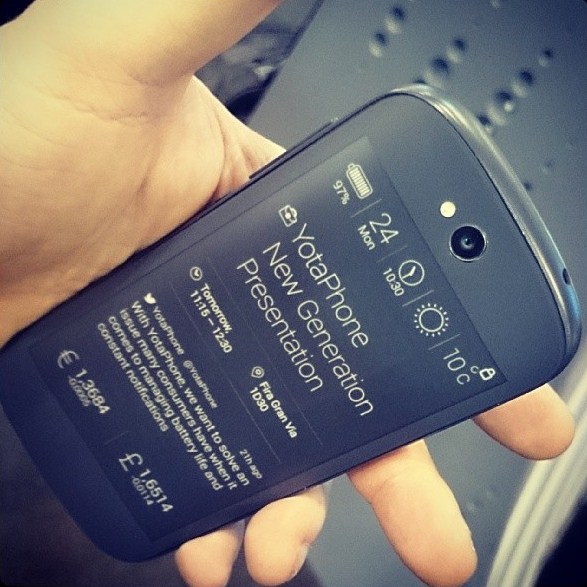Yota Devices
| Yota Devices | |
|---|---|
| Name | Yota Devices Ltd. |
| Gründung | 2009[1] |
| Sitz | Moskau, |
|
Leitung |
Vlad Martynov (CEO) |
| Branche | Smartphones, Modems, Router |
| Homepage | yotaphone.com |
Yota Devices Ltd. ist ein privates russisches Unternehmen aus Moskau. Das Unternehmen ist eine Tochterfirma des russischen Internetdienstanbieters Yota.[2]. Es produziert Geräte wie Smartphones, Modems und Router für die mobile Kommunikation. Chief Executive Officer des Unternehmens ist Vlad Martynov, der Chief Operating Officer ist Lau Geckler.[3]
Geschichte
Das erste entsprechende Gerät entwickelte Yota Devices in 2009. Im Jahr 2012 hatte das Unternehmen mehr als eine Millionen Modems und Router verkauft[4] und damit von 2009 bis 2012 insgesamt mehr als drei Millionen Geräte. Der Halbleiterhersteller Altair Semiconductor arbeitet eng mit Yota Devices zusammen.[5]
Das Unternehmen wurde 2013 mit einen Golden Lion beim Cannes Lions International Festival of Creativity ausgezeichnet.[6] Im September 2017 kam das YotaPhone 3 in China auf den Markt.[7][8]
Produkte (Auswahl)
Yota Egg

Das Yota Egg kam 2009 auf dem Markt. Es war das erste Modem des Unternehmens. Es ist ein portables Gateway zwischen WiMAX- und Wi-Fi-Netzwerken.[9]
- Spezifikationen
- Nutzungsdauer: Bis zu 6 Stunden bei niedriger Belastung, bis zu 3 Stunden bei hoher Belastung
- WiMAX: IEEE 802.16e-2005, Frequenzbereich 2.4 GHz, Signalstärke 200 mW
- Wi-Fi: IEEE 802.11b / g, Frequenzbereich 2.4 GHz, Signalstärke 3 mW
- Batterie: 3,7 V / 2800 mAh
- Eingebaute Antenne
- Maße: 110 x 61,8 x 28,3 mm
- Gewicht: 130 g
YotaPhone

Das Unternehmen zeigte im Februar 2013 auf dem GSMA Mobile World Congress in Barcelona in Spanien das YotaPhone. Das YotaPhone ist ein Android-Smartphone mit der Besonderheit eines E-Ink-Displays auf der Rückseite neben dem üblichen LCD-Display auf der Vorderseite. Da E-Ink-Displays technikbedingt wenig Strom verbrauchen, kann das Display ständig eingeschaltet bleiben um z. B. Nachrichten, Straßenkarten und E-Books anzuzeigen.[10]
Das Gerät hat einen 1.5 GHz Zweikern-Prozessor und eine 13-Megapixel-Kamera auf der Rückseite.[11] Auf der Vorderseite ist ein 4,3 Zoll LCD-Display, auf der Rückseite ein ebenso großes E-Ink-Display.
- Spezifikationen
- CPU: Zwei-Kern-CPU, 1,7 GHz
- Speicher: 2 GByte RAM, 32 GByte Flash
- Front-Display: 4,3 Zoll LCD, 1280 x 720 Pixel
- Back-Display: 4,3 Zoll E-Ink, 640 x 360, 16 Graustufen
- Mobilfunknetze: LTE 800/1800/2600 MHz, UMTS 900/1800/2100 MHz, 802.11 a/b/g/n, Bluetooth 4.0, GPS
- Kamera: 13 MP, LED-Blitz (Back), 1 MP (Front)
- Akku: 1800 mAh
- Betriebssystem: Android, Version 4.2.2
- Maße: 133 mm x 67 mm x 9,9 mm
- Gewicht: 146 g[12]
YotaPhone 2


- Spezifikationen
- CPU: Qualcomm Snapdragon 801 2,2 GHz Quad-Core
- Speicher: 2 GB RAM, 32 GB eMMC
- Front-Display: 5 Zoll AMOLED, Full HD 1920x1080, 16M Farben, 442ppi, Gorilla Glass 3
- Back-Display: 4,7 Zoll E-Ink, 960x540, 235ppi, Gorilla Glass 3, Refreshrate 0,12 Sekunden
- Mobilfunknetze: GSM/EGPRS 850, 900, 1800, 1900 MHz, WCDMA, DC HSDPA, HSUPA Bands 1 (Diversity), 2, 5 und 8, LTE Bands 3, 7 und 20, VoLTE
- Weitere Verbindungen: WiFi 802.11 a/b/g/n/ac (VHT20, MSC 8), MicroUSB 2.0 (SlimPort), Bluetooth 4.0, NFC, A-GPS + GLONASS, Nano-SIM
- Sensoren: Beschleunigungssensor, Kompass, Gyroskop, Annäherungssensor, Umgebungslichtsensor
- Kamera: 8MP AF, LED Flash (Back), 2,1MP (Front)
- Audio: 3.5 mm AV-Connector, FM-Radio
- Akku: 2500 mAh
- Betriebssystem: Android 4.4, KitKat
- Maße: 144,9 x 69,4 x 8,95 mm
- Gewicht: 145 g
YotaPhone 3
- CPU: Octa-Core 2,0 GHz Cortex-A53
- Chipset: Qualcomm MSM8953 Snapdragon 625
- GPU: Adreno 506
- Speicher: 64/128 GB, 4 GB RAM
- Mobilfunknetze: GSM 850 / 900 / 1800 / 1900 - SIM 1 & SIM 2, HSDPA 850 / 900 / 1900 / 210, HSPA, LTE, GPRS, EDGE
- Weitere Verbindungen: Wi-Fi 802.11 a/b/g/n/ac, Dual-Band, WiFi Direct, Hotspot / Bluetooth 4.2, A2DP, LE / A-GPS, GLONASS, NFC
- Front-Display: 5,5-Zoll, AMOLED, Full HD (1080x1920 Pixel)
- Back-Display: 5,2 Zoll, E-Ink Carta
- Kamera: 12 MP f/1.9, Autofokus (Front), 13 MP f/2.2, Dual-LED-Flash (Back)
- Akku: Li-Po 3300 mAh
- Betriebssystem: Android 7.1.1 (Nougat) mit Benutzeroberfläche YotaOS 3.0
- Maße: 153,6 x 75,2 x 7,9 mm
- Gewicht: 170 g
- Sonstiges: Dual-SIM (Nano-SIM), Corning Gorilla Glass 4, FM-Radio, USB Type-C 1.0[13]
Weblinks
- https://www.yotaphone.com/ YotaPhone Homepage
- YotaPhone bei Facebook

- YotaPhone bei X/Twitter

- YotaPhone bei Instagram

- Geräte von Yota Devices bei Wikimedia Commons

- Vorlage:RU-WP
Quellen
- ↑ Yota Devices | CrunchBase
- ↑ YotaPhone: Android-Smartphone mit zwei Bildschirmen - ComputerBase, 12. Dezember 2012
- ↑ http://www.yotaphone.com/#/en/about
- ↑ http://www.yotadevices.com/
- ↑ Altair Powers Yota Devices' New Generation of LTE USB Dongles, 8. Januar 2013
- ↑ Cannes Lions International Festival of Creativity 2013 Award Winners: YOTA - "Two Screens Are Better Than One" - AdForum: Award Winning Ads (abgerufen am 3. Dezember 2013)
- ↑ Yotaphone 3 mit Rückseiten-Display angekündigt | heise online, 24.08.2017
- ↑ Dual-screen YotaPhone 3 is finally official and it's just as kooky as the last two | TechRadar
- ↑ Yota Egg: portable mobile WiMAX to Wi-Fi converter - MuniWireless, 6. Oktober 2009
- ↑ YotaPhone: Vorstellung des Smartphones mit LCD und E-Ink-Display live bei TechStage | heise online, 3. Dezember 2013
- ↑ Watch the YotaPhone e-ink smartphone reveal live on CNET | Mobile - CNET News
- ↑ YotaPhone: das Smartphone mit E-Ink-Zweitdisplay | heise online, 04.12.2013
- ↑ Yota YotaPhone 3 - Full phone specifications
